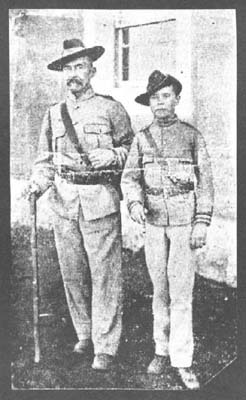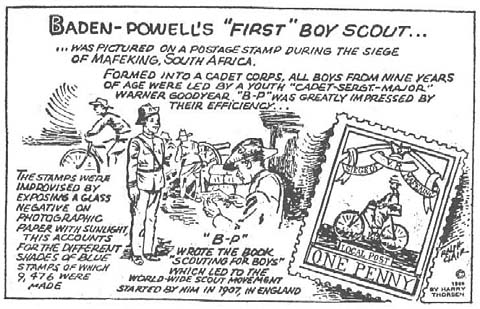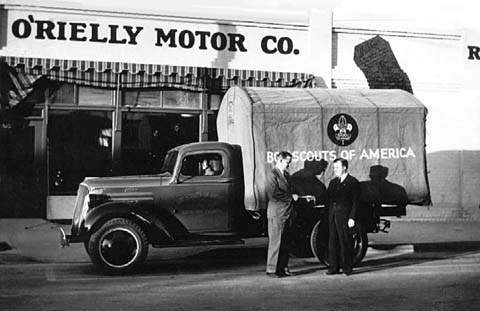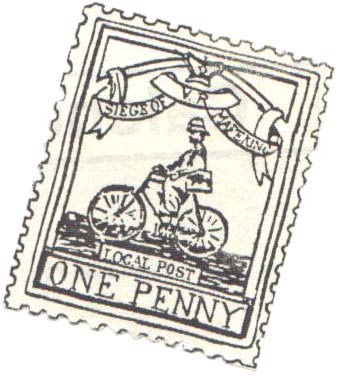







|
|
The Messenger
Edited by Joyce Coon
|

|
Monday, June 20, 2000
MUSEUM MESSENGER -- JUNE 2000 -- VOL. 6 NO. 2
The following article was featured in Volume 1, No. 2 in July 1992.
I think it bears reprinting for many of our newcomers.
THE MUSEUM MESSENGER LOGO
The Museum Messenger has chosen the Scout on a Bicycle Stamp as its
logo. The story behind it contains much Scout history.
When the Boer War broke out in South Africa in 1899, Colonel Baden-Powell
was given the assignment to hold Mafeking (a railroad center in southern
Africa) at all costs until a relief column from Capetown could reach
him with reinforcements. This proved to be a Herculean task, as Baden-Powell
had only 1,000 regular British troops to defend a town of about 9,000
citizens, while surrounded by 10,000 Boer army regulars.
Realizing that it would be months before the relief troops could arrive,
Baden-Powell organized all the natives into various support groups.
The siege started October 11, 1899 and lasted until May 17, 1900, 217
days. During this time Baden-Powell used all the strategies of his years
of military service to hold out against the superior Boer forces.
To prevent spying and espionage the village was divided into four quadrants
and the only communication between sections was by mail. The people
were not allowed to travel from one section to another without special
authorization. Communications between various military posts had to
be delivered by messengers. Due to the shortage of military personnel,
Baden-Powell had the boys aged 13 or older organized into a cadet corps
known as the Brigade. They were outfitted in military uniforms and mounted
on bicycles to deliver the military messages. These cadets were called
Scouts. Captain Charles Goodyear was given command of organizing the
cadets and his son was made Cadet Sergeant-Major Warner Goodyear, the
first Scout. Non-military letters were to be charged for delivery in
order to help pay for services by non-military personnel. This necessitated
the printing of stamps for non-military letters. Mafeking had printing
facilities but no photoengraving equipment to produce halftone cuts.
The Engineer Corps had photograph and drafting equipment to produce
maps and necessary machine blueprints so it was possible to produce
the stamps by the drafting blueprint method. These stamps were “blue
printed” by the engineering unit of the military in 1900 using the picture
of a cadet on a bicycle for the 1 cent stamp, and the bust of Baden-Powell
on the 2 cent and 3 cent stamps. The 1 cent stamp became known as the
1 cent Scout Blue—the first Scout stamp printed. Only 9,476 stamps were
produced. The Scout Museum of Southern Arizona has on display a 1 cent
Scout Blue stamp with a 1900 cancellation date. (By Otis H. Chidester,
Curator)

Charles and Warner Goodyear, the first Scoutmaster and Scout

In keeping with bicycling the following was written by Dr. James B.
Klein, June 21, 1997:
Although the sight of bicyclists wending their way up and down the Mt.
Lemmon Highway is now commonplace, the first known bicycle trip to the
top of Mt. Lemmon took place on June 18, 1916, at a time when there
were no motor vehicle roads into the high country.
F.E.A. Kimball, a well-known Tucson printer and secretary of the newly
incorporated Summerhaven Land and Improvement Co., conceived of the
bicycle expedition as a means of accurately measuring distances from
point to point on the then most commonly used south slope trail network
to Soldier Camp and Summerhaven. Accompanying the 52-year old Kimball,
and helping him signpost the mileage with red paint at selected points
was Russell Jacobus, son of former Tucson mayor Preston N. Jacobus and
a May 1916 honor graduate from Tucson High School.
The pair started in downtown Tucson and rode 14.1 miles to the Lowell
Ranger Station, located about where the Sabino Canyon Visitor Center
is situated today. From the Lowell Ranger Station, they took the Phoneline
and Palisade Trails 14.2 miles to the junction with the Soldier Trail,
where the Palisade Ranger Station is currently located. They then took
the Soldier Trail 2.3 miles to the Soldier Camp Ranger Station, which
is no longer in existence. From there, they went to Summerhaven and
on to the top of Mt. Lemmon where a fire lookout tower was then located.
The total distance from downtown Tucson to the Mt. Lemmon fire lookout
tower, as recorded on a bicycle odometer, was 35.2 miles. The trip to
the top must have been taxing since Kimball and Jacobus did not return
to Tucson until two days later.
What’s New
*The first Boy Scout troop in Tucson was established on April 20, 1911,
with Harold Steele serving as the first Scoutmaster. Because Mr. Steele
was very busy as principal of Tucson High School and of the 7th and
8th grades, he stepped down as Scoutmaster during the first week of
December 1911 and became the commissioner for the first Council organi-zed
in Tucson that same week in December. Mr. Steele received his official
commission as Council Commissioner from the National Council of the
Boy Scouts of America on April 9, 1912. The second Scoutmaster in Tucson
was William J. Galbraith who later moved to Phoenix and became Attorney
General for the State of Arizona in the early 1920’s.
*From the earliest days of the scouting program in Tucson, the Santa
Catalina Mountains have served as the primary area for hiking, camping
and outdoor adventure. Before the Control Road from the Oracle side
of the Catalinas was put through to Summerhaven and Soldier Camp in
the summer of 1920, Scouts got to the high country by hiking up the
Phoneline, Palisade and Soldier Trails. Scouts from Tucson camped in
Bear Wallow in 1912, 1913 and 1914. In 1915, they camped at Frank Weber’s
homestead, which acquired the name Summerhaven in 1916.
Once the Control Road made it possible to drive to Summerhaven and Soldier
Camp, it became feasible to establish a permanent Council camp. Over
the Memorial Day weekend of 1921, the Coronado National Forest Supervisor
offered a delegation of Tucson, Arizona Council (it did not become Catalina
District Council until 1922) leaders its choice for a camp location
from among three possibilities. The three choices included a site above
Summerhaven (about where the ski area is now), a site above Soldier
Camp (probably about where a University of Arizona observatory is now
located), and a site close to Burnt Cabin (where the Palisade Ranger
Station is now located).
The Council delegation, headed by then president James M. Lawton and
vice-president and immediate past president Joel I. Butler, M.D., chose
the Burnt Cabin site for three principal reasons:
1. Ample water was available from springs, which still supply water
to Camp Lawton.
2. The location was at the junction of two established trails—the Palisade
Trail and the Soldier Trail; the latter trail connected directly with
Soldier Camp, about 3 1/2 miles away.
3. The location was easily served by the telephone line connecting Lowell
Ranger Station at lower Sabino Canyon with the Soldier Camp Ranger Station.
This allowed the camp director to contact the outside world in the event
of an emergency.
Shortly after the Burnt Cabin site was chosen by the council delegation,
it was decided to name the new camp for James M. Lawton. Mr. Lawton,
who was born in 1877, was an accountant who had come to Tucson in 1914
from his previous job with a prominent copper mining company in Cananea,
Sonora. He was prompted to leave Cananea because of the turmoil associated
with the Mexican Revolution. He died in Tucson in 1958. Besides his
one year as Council president, he served a number of years on the Council
executive board.
*Shower’s Point, which is a massive granitic bluff close to Camp Lawton,
is named after Hazen Shower, who was Council Executive from 1927-1934.
During his tenure, Mr. Shower initiated the practice of having Camp
Lawton Scouts hike over to and climb to the top of Shower’s Point in
order to see the Tucson valley below and to conduct an evening campfire
ceremony.
*Barnum Rock, which is close to San Pedro vista on the Mt. Lemmon Highway,
is named after Willis E. Barnum, who became a scout leader in Tucson
in 1916 and who was Council Commissioner in 1921 when Camp Lawton was
established. During the early 1920’s, it was customary for honor Scouts
at Camp Lawton to be stationed on top of Barnum Rock to assist the Forest
Service as fire lookouts. It is possible, although not yet proven, that
a telephone line was strung to Barnum Rock so that Scouts could quickly
notify Forest Service officials in the event of a fire. If such a telephone
line existed, it would have been a spur from the line extending from
the Soldier Camp Ranger Station to the Brush Corral Ranger Station and
which passed along the base of Barnum Rock.
*The foregoing information (April 18, 1998) was compiled by James Klein,
M.D. as part of the ongoing historical research work of the Museum.

1936 First Council-owned Scout Truck
Secured from Frank O’Rielly in February 1936, at which time Frank gave
us his check for $1000 to apply on the purchase. This truck was used
to transport scouts, haul scouting supplies and for scout trips generally
for many years. It was finally sold about 1955 to one of the Smallhouse
boys who, in turn, used it for several years hauling wood and other
supplies from his father’s ranch to Tucson. Shown in the picture is
Walter Sims, then Scout Executive of Catalina Council, accepting title
from Frank O’Rielly.
(This truck was also driven by Col Alan B. Thomas as referenced in the
March 2000 Messenger.)
YES, WE ARE OPEN
The Museum is now open on a limited basis:
Tuesday 6 pm—9 pm
Thursday 9 am —12 noon
Saturday 9 am —12 noon
At such a time when the demand is greater, the open hours will expand.
However, private tours are available and we welcome everyone. Please
come see us during our open hours, or schedule a tour for your group
or organization.
To schedule a tour for your Den, Troop or Post, or to arrange a private
visit,
Call (520)326-7669
The Museum is located at:
1937 E. Blacklidge
Tucson, AZ 85719
New Collector’s Badge: A new Museum collector’s badge is being created
depicting the “One Penny Bicycle Stamp” which is part of the logo of
our Messenger. As reprinted in this issue, there is a great deal of
history behind the stamp. We will advise you when it will be available
for purchase.

Scouting Is:—–
Not just a boy in a khaki suit
to catch the eyes of men—
But something which is more than display.
It teaches morality—it shows the way.
It’s not just a meeting once a week,
At which the smart teach the weak;
But something tingling, something real,
That tells of love—and you can feel
That wonderful friendship that all need
To be a real man—today—indeed.
It is not just a hike or extended trip,
But the developing of real friendship.
The Oath and Laws are something to love
As coming down from heaven above.
It is not just something that can be bought.
What little watchward can be compared
But that which is finer than by senses sought
To that of the motto—BE PREPARED”
It’s not just a motto framed for the wall—
A bit of hallowed sentiment—that’s all,
But something graven deep into the heart
Until it becomes a soul and self apart.
Wm. H. Watson, Scout Executive ca. 1932
Museum Messenger 6.2 -- June, 2000
This is the quarterly publication of the Chidester Scout Museum, a non-profit
organization founded in 1984 and incorporated under the laws of the
state of Arizona. Articles may be submitted by e-mail to Joyce Coon,
editor, at BJCoonTuc@aol.com or to the Museum’s address: Otis H. Chidester
Scout Museum of Southern Arizona, Inc., 1937 E. Blacklidge, Tucson AZ
85719.
We preserve the memories of Scouting
|